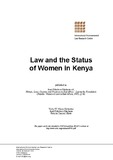| dc.description.abstract | Kenya has a geographical area of 583,000 square kms. and is bordered by Somalia to the north
east, Indian Ocean to the east, Ethiopia to the north, Uganda to the west and Tanzania to the South.
Currently, the population is estimated at 23 million, the last census having been held in 1989.
Kenya gained Independence in 1963 from the British Colonial Government. Politically the country
is divided into 188 parliamentary constituencies, which are represented in parliamentary duly elected
members. As of December 1991, Kenya adopted the multiparty system, which has seen emergence
of a number of parties each with a different agenda. Each party has indicated, interest in involving
women in their policies or considering women’s issues.
Women constitute over 50% of Kenya’s population, but the majority of them are among the illiterate
and poor in the country. A number are still affected by customary laws and practices which have for
so long perpetuated their oppression. In this chapter, we look at the legal status of women in Kenya | en_US |

